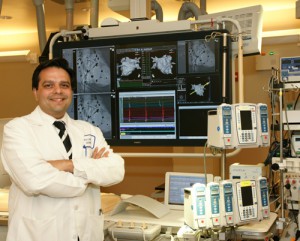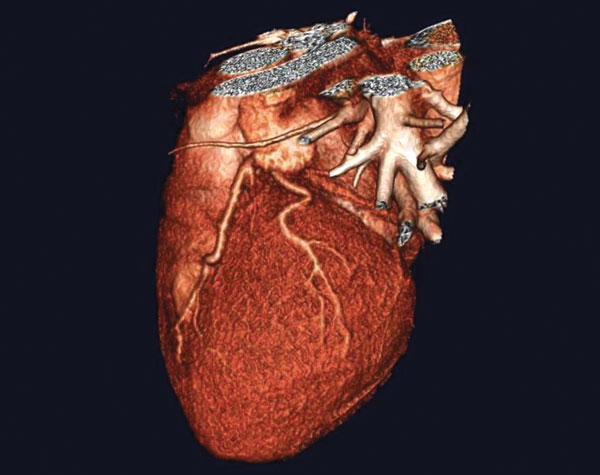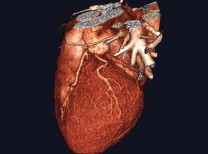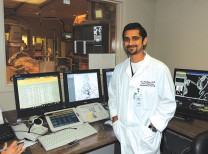
Dr. Bhakta and Desert Regional’s Stereotaxis
Desert Regional successfully treating patients
Some patients with atrial fibrillation (or AFib) and heart rhythm disorders may be able to say good-bye to their medications thanks to new technology offered at Desert Regional Medical Center.
AFib occurs when the heart’s electrical system has a problem that causes the heart to fibrillate, or beat very rapidly. When this occurs, the heart cannot pump blood properly throughout the body. The new technology, called Stereotaxis Robotic Navigation, enhances a cardiologist’s ability to treat problem cells that are causing the heart’s electrical system to misfire. Desert Regional has been actively using the robotics since August with promising results.
According to the American Heart Association, AFib is the most common type of heart rhythm disorder, affecting more than 2.7 million people in the U.S. AFib can cause chest pain; however, in some cases, people may not feel any symptoms. The likelihood of developing AFib increases with age, and those affected are five times more likely to have a stroke.
“Among the senior population, the percentage of people with atrial fibrillation can be as high as 8 to 10 percent, and that’s a significant number,” said Dr. Hetal Bhakta, MD, a cardiologist with Desert Regional Medical Center who specializes in electrophysiology, the treatment of heart rhythm disorders. “A lot of the episodes are silent, so these patients don’t know they even have atrial fibrillation.”
AFib is a serious illness. When the heart cannot move blood properly, it may pool in the chambers of the heart and blood clots may form. When a clot blocks a blood vessel in the brain, heart failure or stroke may occur.
Palm Springs real estate broker Edward Leao experienced serious and debilitating health issues that can come with atrial fibrillation. Following cardiac bypass surgery and a heart valve replacement, Leao continued to have severe fatigue and other symptoms that made it impossible for him to work. “I simply could not stand up for any time at all,” Leao said. “I would have to sit down or lay down, or I would just fall down.”
After coming to Desert Regional for an unrelated health issue, Leao met Dr. Bhakta, and they discussed the catheter ablation procedure for his heart rhythm disorder. During catheter ablation, a cardiologist inserts a catheter (a thin flexible tube) into the blood vessel of the groin, arm or neck. A wire inside that catheter is connected to a special machine that can generate radiofrequency energy at its tip. Using sophisticated imaging technology, the cardiologist can navigate to the places on the heart that are causing the electrical signals to misfire. The radiofrequency energy heats the problem cells and deactivates them. Electrical signals can then move normally through the heart and a regular rhythm can be restored.
Leao underwent the ablation procedure at Desert Regional Medical Center in February 2011. “Immediately I felt the difference,” Leao said. “I started getting stronger. I had been totally debilitated for so long, I was afraid to walk far because of my previous experience falling to the ground.”
By August of that year, Leao felt he was back to normal. “I took a vacation to Napa and I started out slow, but eventually I was walking three miles in the morning without any problems at all,” he said. “That’s when I decided my life was back to normal. I don’t get dizzy anymore. The first year I took two-hour naps. Now I don’t even take naps.”
Desert Regional Medical Center installed the Stereotaxis navigation equipment in June to make ablation procedures easier for physicians and more accurate for patients. Rather than push a catheter manually through a patient’s blood vessels, with Stereotaxis navigation the cardiologist can steer the catheter remotely while watching its progress on a high-definition computer screen. Powerful magnets lock onto the tip of the catheter and allow it to be steered, improving both precision and safety.
Dr. Bhakta adds, “Manual ablation is like trying to paint a canvas on a small fishing boat in the middle of the ocean with all the waves, compared with painting that same canvas on a steady cruise ship.”
This advanced technology also reduces the use of radiation exposure because the physician needs to take fewer x-ray pictures than manual ablation methods would require. According to a recent study, Stereotaxis technology is ten times less likely to injure a patient than manual treatments that do not use robotic navigation and requires approximately one-third less time exposed to radiation.
For more information on this technology, go to www.desertregional.com/afib.











































Comments (0)